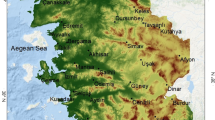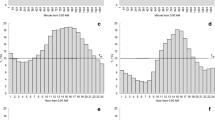Abstract
The aim of this study was to examine different methods for determining growing degree-day (GDD) threshold temperatures for two phenological stages (full bloom and harvest) and select the optimal thresholds for a greater number of apricot (Prunus armeniaca L.) cultivars grown in the Belgrade region. A 10-year data series were used to conduct the study. Several commonly used methods to determine the threshold temperatures from field observation were evaluated: (1) the least standard deviation in GDD; (2) the least standard deviation in days; (3) the least coefficient of variation in GDD; (4) regression coefficient; (5) the least standard deviation in days with a mean temperature above the threshold; (6) the least coefficient of variation in days with a mean temperature above the threshold; and (7) the smallest root mean square error between the observed and predicted number of days. In addition, two methods for calculating daily GDD, and two methods for calculating daily mean air temperatures were tested to emphasize the differences that can arise by different interpretations of basic GDD equation. The best agreement with observations was attained by method (7). The lower threshold temperature obtained by this method differed among cultivars from −5.6 to −1.7°C for full bloom, and from −0.5 to 6.6°C for harvest. However, the “Null” method (lower threshold set to 0°C) and “Fixed Value” method (lower threshold set to −2°C for full bloom and to 3°C for harvest) gave very good results. The limitations of the widely used method (1) and methods (5) and (6), which generally performed worst, are discussed in the paper.



Similar content being viewed by others
References
Arnold CY (1959) The development and significance of the base temperature in a linear heat unit system. Proc Am Soc Hort Sci 74:430–445
Črepinšek Z, Kajfež-Bogataj L, Bergant K (2006) Modelling of weather variability effect on fitophenology. Ecol Model 194:256–265
Degrandi-Hoffman G, Thorp R, Loper G, Eisikowitch D (1996) Describing the progression of almond bloom using accumulated heat units. J Appl Ecol 33:812–818
Galán C, García-Mozo H, Cariñanos P, Alcazar P, Dominguez-Vilches E (2001) The role of temperature in the onset of the Olea europaea L. pollen season in southwestern Spain. Int J Biometeorol 45:8–12
Guerriero R, Monteleone P (2006) Thermal requirement from blooming to ripening in some apricot cultivars. Acta Hort 701:95–98
Janssen PHM, Heuberger PSC (1995) Calibration of process-oriented models. Ecol Model 83:55–66
McMaster GS, Wilhelm WW (1997) Growing degree-days: one equation, two interpretations. Agric For Meteorol 87:291–300
Milatović D, Ruml M, Vulić T (2008) Heat requirement from blooming to maturing in apricot cultivars. XIV International symposium on apricot breeding and culture, Matera (Italy), 16–20 June 2008. Book of abstracts, poster 5.11
Richardson EA, Seeley SD, Walker DR, Anderson JL, Ashcroft GL (1975) Pheno-climatography of spring peach bud develoment. HortScience 10:236–237
Ring DR, Harris MK, Jackman JA, Henson JL (1983) A Fortran computer program for determining start date and base temperature for degree-day models. The Texas Agric Exp St Bull MP-1537. The Texas University System, College Station
Snyder RL, Spano D, Cesaraccio C, Duce P (1999) Determining degree-day thresholds from field observations. Int J Biometeorol 42:177–182
Tabuenca MC, Herrero J (1965) Influencia de la temperatura en la época de floración de frutales. An Aula Dei 8:115–153
Valentini N, Me G, Spanna F, Lovisetto M (2004) Chilling and heat requirement in apricot and peach varieties. Acta Hort 636:199–203
Weiss A, Hays CJ (2005) Calculating daily mean air temperatures by different methods: implications from a non-linear algorithm. Agric For Meteorol 128:57–65
Wielgolaski FE (1999) Starting dates and basic temperatures in phenological observations of plants. Int J Biometeorol 42:158–168
Yang S, Logan J, Coffey DL (1995) Mathematical formulae for calculating the base temperature for growing degree-days. Agric For Meteorol 74:61–74
Yildiz AA, Yildiz A, Kaska N, Çaglar S (1997) Effective heat summations of some apricot cultivars and types in the Mediterranean region of Turkey. Acta Hort 441:423–426
Acknowledgement
This study was conducted within the research project 20103B supported by the Serbian Ministry of Science and Technological Development.
Author information
Authors and Affiliations
Corresponding author
Rights and permissions
About this article
Cite this article
Ruml, M., Vuković, A. & Milatović, D. Evaluation of different methods for determining growing degree-day thresholds in apricot cultivars. Int J Biometeorol 54, 411–422 (2010). https://doi.org/10.1007/s00484-009-0292-6
Received:
Revised:
Accepted:
Published:
Issue Date:
DOI: https://doi.org/10.1007/s00484-009-0292-6




